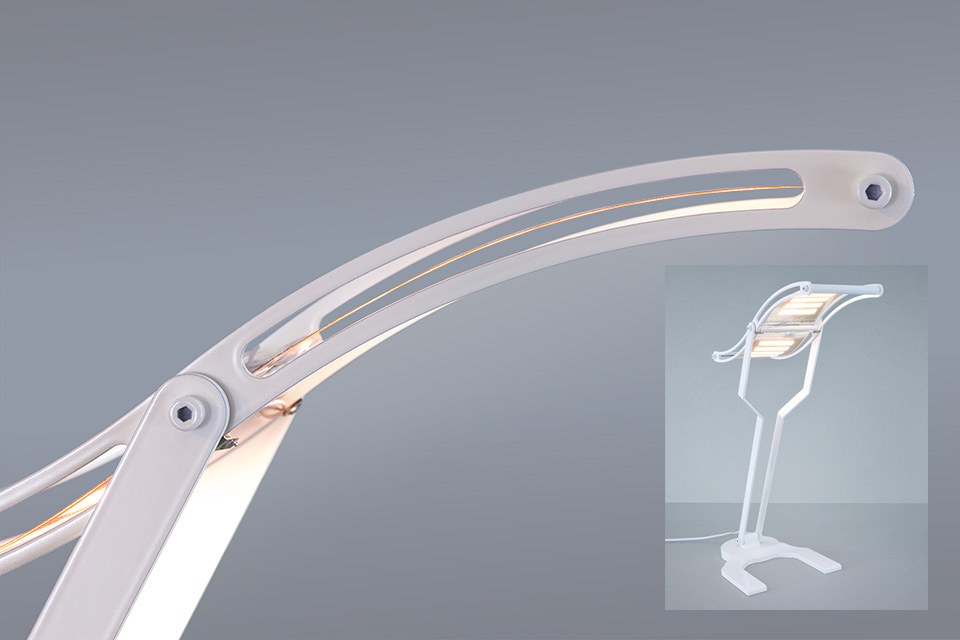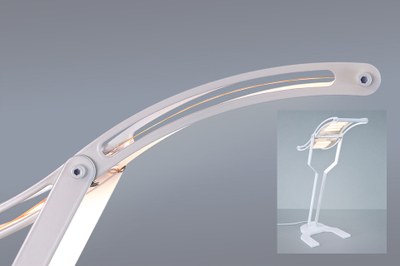Tridonic Dresden and Fraunhofer COMEDD Present a Desk Luminaire with Flexible OLED from the Roll
The joint OLED project R2Flex has been successfully finished now. As a result Fraunhofer COMEDD and Tridonic Dresden (formerly LEDON OLED Lighting) present a demonstrator of a desk luminaire with flexible OLED. The joint project R2Flex dealt with the production of highly efficient organic devices on flexible substrates, manufactured in a roll-to-roll process technology. R2Flex was funded by the Federal Ministry for Education and Research (BMBF) with a total sum of about 11 million Euros over a period of 2.5 years.
The overall aim of the joint project R2Flex included the development of essential components for highly efficient OLED technology. The OLED should be processed in a roll-to-roll process technology on cost-effective substrates, especially on metal foil. This technological approach should help to solve a main problem of the production of OLED: to be able to offer and use OLED for lighting and signage applications, low costs are essential. This key fact could not be achieved by the conventional technology approaches because of the high costs of the coating technologies and materials.
OLED Roll-to-Roll Technology for Flexible Substrates:
Fraunhofer COMEDD has improved its roll-to-roll research line, which consists of a vacuum system for the evaporation of organic materials. Furthermore, it includes a coating and lamination system, which can be used under nitrogen atmosphere, and an optical inspection system for defect control and processes monitoring on flexible foils. Within the R2Flex project the OLED technology of established processes could successfully be transferred from rigid substrates to roll-to-roll processes. Especially, the processes for patterning of substrates and encapsulation of the foils were developed. However, one of the most important key challenges of the investigations was the deposition technology of complex OLED structures. To achieve e.g. white OLED, many different layers with a layer thickness in the range of several nanometers have to be deposited precisely on top of each other. Performing this process within a roll-to-roll line was a complex task. Nevertheless, a white OLED could be demonstrated successfully on metal foil.
OLED Product Integration:
Next to the manufacturing of OLED on flexible substrates also aspects of their integration for possible products have been investigated by Tridonic Dresden GmbH & Co. KG. Therefore, Tridonic Dresden evaluated technologies for the secure and cost-efficient electrical contacting of flexible OLED on metal substrates and their integration in luminaires. Resulting from this the problem of contacting through the barrier film could be solved together with Fraunhofer COMEDD. Such a solution has been integrated successfully into the roll-to-roll research line of Fraunhofer COMEDD.
Project Results Combined in a Desk Luminaire:
As a result of the joint project R2Flex a demonstrator in form of a gracile desk luminaire could be manufactured. Therefore, two flexible OLED on metal substrate have been used, which were produced at Fraunhofer COMEDD. The modules were serially connected via flexible contacting. The luminaire combines both straight and curved shapes. The curved shape of the head section of the luminaire impressively presents the flexibility of the OLED. The reduced and open design highlights the flexible OLED in an attractive and esthetic way.
About OLED:
An organic light-emitting diode (OLED) consists of a thin organic system of layers (about 200 to 400 nanometers), which lies between two electrodes (anode and cathode). In total this area light source, which is evaporated in vacuum on flexible foil or metal substrates, is thinner than two millimeters. By applying electrical current light is been generated within the system of layers and emits through one of the electrodes. In contrast to conventional light sources OLED light modules spread an area light with a high color quality, which is very pleasant for the human eye. Another advantage: the area light of OLED does not blind. Thus OLED do not need any reflectors to minimize the dazzle effect. In general OLED belong to some of the most efficient light sources.
R2Flex Consortium:
Besides Fraunhofer COMEDD (Förderkennzeichen: 13N11058) and Tridonic Dresden GmbH & Co. KG (formerly LEDON OLED Lighting GmbH & Co. KG) (Förderkennzeichen: 13N11061) the TU Dresden with the Institute for Applied Photophysics (IAPP, leader of the consortium), the Fraunhofer Institute for Electron Beam and Plasma Technology (FEP), Novaled AG, Heliatek GmbH, VON ARDENNE Anlagentechnik GmbH, Creaphys GmbH, 3D-Micromac AG, LayTec GmbH and ALANOD Aluminium-Veredelung GmbH & Co. KG were partners within the project funded by the Federal Ministry for Education and Science (BMBF).
About Tridonic Dresden:
Since July 2013 Tridonic Dresden GmbH & Co. KG is a 100% subsidiary of the Zumtobel Group. Originally Tridonic Dresden was founded as a joint-venture company under the leading of LEDON OLED Lighting GmbH & Co. KG by the Zumtobel Group together with the Fraunhofer Gesellschaft and some employees of the Fraunhofer Institute for Photonic Microsystems (IPMS) in autumn 2009. The head office is in Dresden – one of the most important centers for OLED technology in Europe.
Main aim of Tridonic Dresden is the further processing and finishing of OLED lighting elements to applicable OLED modules. Some of our core competencies are the electrical integration and electronically control and driving of OLED light modules as well as the improvement of the quality of light. More information: www.tridonic.com/oled
About Tridonic:
Tridonic, with head office in Dornbirn/Austria, develops, manufactures and distributes controllers and drivers for different light sources, light management systems, LED- and OLED-solutions as well as packaging of integrated circuits. Through committed partnerships, expert service skills and technical know-how, we enable our customers to implement functionally and economically superior lighting. Tridonic is a subsidiary of the Zumtobel Group. 1946 employees in 27 branch offices generated a turnover of 378 million euro in the financial year 2012/13. More than 300 engineers in research and development create intelligent lighting concepts based on sophisticated systems and products. More than 650 inventions and 2100 patents document Tridonic´s innovative capabilities. Our customers include luminaire manufacturers, producers, who use lighting solutions, architects, lighting and electrical designers, electrical installers and wholesalers.
Tridonic has been engaged in the quest for perfect light for over 50 years. Today Tridonic is renowned for its excellent products and services dedicated to the fascination of light. Corresponding to its slogan "enlightening your ideas" the company supports its customers in developing energy efficient lighting solutions. More information: www.tridonic.com
About Fraunhofer COMEDD:
Fraunhofer COMEDD was founded as an independent research institution of the Fraunhofer-Gesellschaft in order to transfer the results of research and development in the field of organic materials and systems to production. The institution combines research and development works for the production, integration and technology of organic electronic devices. The focus of Fraunhofer COMEDD lies in customer- and application orientated research, development and pilot fabrication of novel module concepts and fabrication methods for these organic electronic devices. Fraunhofer COMEDD is an European-wide leading production-related research and development center for organic semiconductors focusing on organic light-emitting diodes and vacuum technology.


